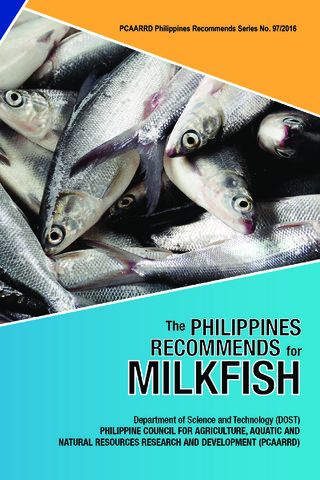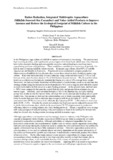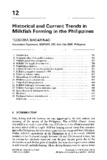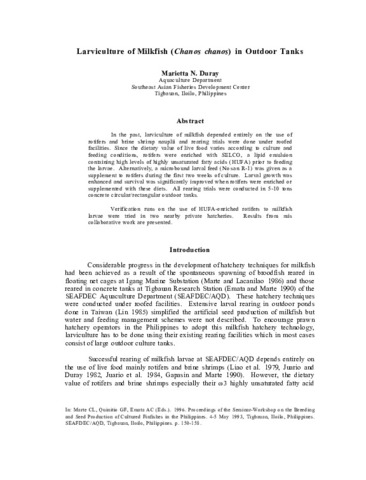The Philippines recommends for milkfish

Associated URL
elibrary.pcaarrd.dost.gov.phDate
2016Author
Page views
540Metadata
Show full item record
Share
Description
With the aim to provide updated technology for milkfish production, the Philippine Council for Agriculture, Aquatic and Natural Resources Research and Development of the Department of Science and Technology (DOST-PCAARRD) published a new edition of The Philippines Recommends (PR) for Milkfish, which was first published in 1983.
Written by experts on aquaculture from Santeh Aquaculture Science and Technology Foundation, Inc., University of the Philippines (UP) Visayas-College of Fisheries and Ocean Sciences, Southeast Asian Fisheries Development Center-Aquaculture Department (SEAFDEC-AQD), and UP Los Baños-College of Economics and Management, the book consists of up-to-date material on milkfish production from fry and fingerling production, grow-out culture, up to postharvest handling and processing.
It also tackles pond and cage culture in detail and marketing and cost and return analysis in milkfish production. The PR for Milkfish 2016 includes information from PCAARRD-funded National Milkfish R&D Program.
The book hopes to lessen the country’s dependence on imported fry as it encourages sufficient investment in hatcheries and active participation of smallholders in larval rearing and fry production.
Suggested Citation
The Milkfish Technical Committee 2016. (2016). The Philippines recommends for milkfish. Los Baños, Laguna, Philippines: DOST-PCAARRD.
Contents
- Foreword
- Acknowledgment
- The Milkfish Technical Committee
- Glossary of Terms
- List of Abbreviations and Acronyms
- Introduction
- Commodity Profile
- Fry Production
- Broodstock Development and Management
- Hatchery Technology
- Market Outlets and Supply Chain
- Cost and Return
- Fingerling Production
- Nursery/Fingerling Production System
- Pond Preparation
- Fry Sourcing
- Stocking of fry in the Nursery Pond
- Care of Stock in the Nursery
- Nursery Harvest or Transfers
- Counting, Packing, and Transport
- Market Outlets
- Cost and Return
- Pond Culture
- Site Selection
- Pond Layout and Design
- Construction
- Pond Preparation
- Feeds and Feeding
- Water Management
- Health Management
- Preventive Measures against Off-flavor
- Grow-Out System
- Mechanization
- Harvesting and Market Outlets
- Cost and Return
- Cage Culture
- Fingerling Sourcing, Conditioning, and Transport
- Acclimation and Stocking
- Site Selection
- Cage Design and Layout
- Culture Techniques
- Feeds and Feeding
- Health Management
- Precautionary Measures against Fishkill
- Harvesting and Market Outlets
- Cost and Return
- Market Supply Chain
- Pen Culture
- Postharvest Handling and Processing
- Postharvest Handling
- Hygiene and Sanitation among Fish Harvesters and Handlers
- Different Product Forms
- Market Outlets
- Exports
- References
Subject
Taxonomic term
Collections
Related items
Showing items related by title, author, creator and subject.
-
Ration reduction, integrated multitrophic aquaculture (milkfish-seaweed-sea cucumber) and value-added products to improve incomes and reduce the ecological footprint of milkfish culture in the Philippines
de Jesus-Ayson, Evelyn Grace T.; Borski, Russel J. (AquaFish Collaborative Research Support Program, Oregon State University, 2012)In the Philippines, cage culture of milkfish in marine environments is increasing. The practice uses high stocking densities, with significantly greater inputs of artificial feeds which more often than not, have led to ... -
Historical and current trends in milkfish farming in the Philippines
Bagarinao, Teodora (Academic Press, 1998)This chapter focuses on the historical and current practices of milkfish farming in the Philippines. The Philippines ranks among the top 12 largest fish producers in the world and the milkfish, Chanos chanos, is the official ... -
Larviculture of milkfish (Chanos chanos) in outdoor tanks
Duray, Marietta N. (Aquaculture Department, Southeast Asian Fisheries Development Center, 1996)In the past, larviculture of milkfish depended entirely on the use of rotifers and brine shrimp nauplii and rearing trials were done under roofed facilities. Since the dietary value of live food varies according to culture ...





